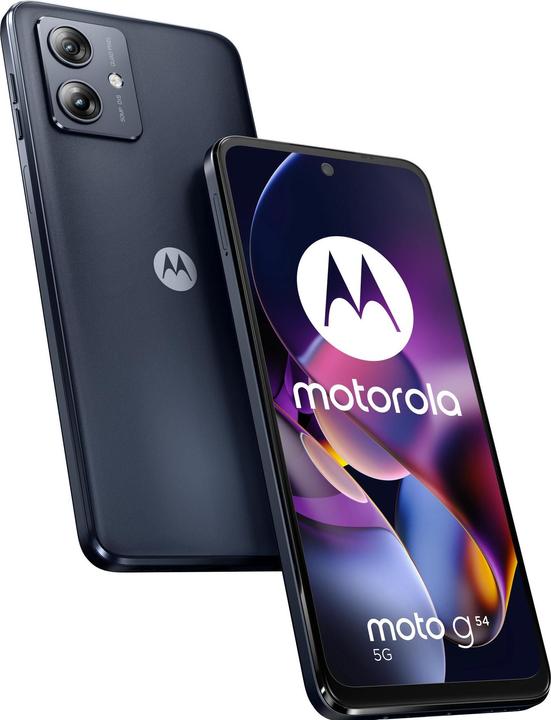
Motorola Moto G54
256 GB, Midnight Blue, 6.50", SIM + eSIM, 5G

The price difference between the Moto G54 and the Moto G84 is around 100 euros or francs. But the more expensive smartphone doesn’t always come out on top in my test. As a result, the extra charge isn’t worth it for me.
I can recognise the different display technologies of the Moto G54 and G84 with the naked eye. The colour options also set the two smartphones apart from each other. Depending on your choice, the back is made of smooth acrylic or soft, non-slip imitation leather. The effects of the installed processors or the different-sized batteries, however, aren’t as obvious.

Motorola Moto G54
256 GB, Midnight Blue, 6.50", SIM + eSIM, 5G

As with the Edge 40 Neo, Motorola entices users with Pantone shades for the more affordable Moto G models. Depending on your choice, the back is made of either plastic or imitation leather. Both my test devices come in the latter. I like the soft, non-slip material. Beyond colours, the Moto G54 and Moto G84 don’t differ in terms of design or materials. The key specs at a glance:
The larger apertures on the main camera of the Moto G54 could indicate better image quality. On the other hand, the Moto G84 has an ultra-wide-angle camera, is better protected against water and offers better display technology with OLED.
Despite many similarities – size, resolution, refresh rate – the difference in the displays is immediately apparent. The OLED screen of the Moto G84 is brighter, meaning that, among other things, whites don’t have a yellowish tint like on an LCD.
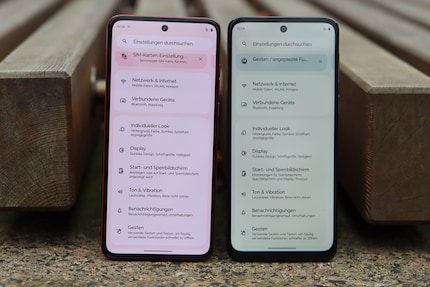
If I don’t look directly at the touchscreen, I also notice that the Moto G54 has a significantly smaller viewing angle.
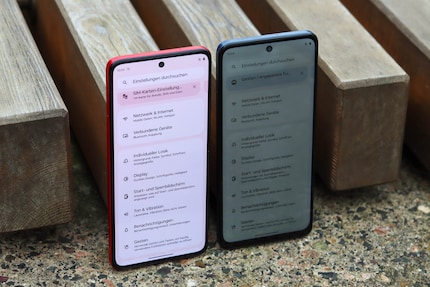
The Moto G54 is worse in comparison. However, the LCD itself is a usable display, the disadvantages of which I can offset against the lower price.
Differences in performance are minimal. Nevertheless, Motorola’s selection seems contradictory. The cheaper Moto G54 features a newer system-on-a-chip (SoC), the Mediatek Dimensity 7020, presented in the first quarter of 2023. The Snapdragon 695 in the Moto G84, on the other hand, has been around since the end of 2021 and achieves lower scores in Geekbench 6 and PCMark Work.
Geekbench doesn’t deliver any results for the Moto G54 in the GPU tests, but I don’t notice any differences in everyday use regardless, even in games. The differences measured in the CPU tests are also too minor to be noticed in practice. But it’s interesting that the Moto G84’s larger RAM doesn’t help it achieve better scores. You can do everything with both smartphones, but you may have to accept slightly longer loading times than with more powerful smartphones – or sacrifice the best possible graphics when playing games.
Nominally, the Moto G54 and the Moto G84 have the same battery capacity with 5,000 mAh. The effects of the G84’s energy-saving hardware can be seen in the Work 3.0 Battery Life test at full display brightness. Both leave the more expensive Edge 40 Neo behind.
I attribute a large part of the longer battery life to the OLED display of the Moto G84. On the other hand, I also get through the day well with the Moto G54.
The differences are more noticeable when charging. The Moto G84 can take up to 30 watts and is half charged in just over 30 minutes with the supplied power adapter. It takes 75 to 85 minutes until the battery is full. The Moto G54 only charges at half the power, a maximum of 15 watts, which draws out the charging time but doesn’t double it.
Nominally, both Moto smartphones have almost identical main cameras. The second camera on the Moto G54 is a 2-megapixel macro camera that doesn’t deliver any usable pictures. The ultra-wide-angle camera of the Moto G84, on the other hand, offers real added value – without being perfect in all disciplines.
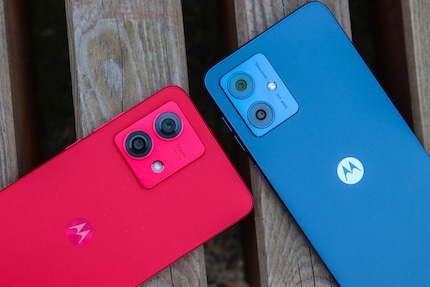
The Moto G54 surprises me by not using Pixel Binning, instead saving photos in full resolution with 50 megapixels. The Moto G84, on the other hand, uses a resolution of 12.5 megapixels. Motorola has hidden the option to use full resolutions under «More» in the camera app.
If I compare both pictures despite the different resolutions, the Moto G54 impresses me with a slightly higher level of detail and somewhat stronger colours.
Looking at the bridge, it becomes clear that the Moto G84 has a smaller focal length. I much prefer its depiction of the sky and reflections on the water.
In the dark, pictures taken with automatic mode on the Moto G84 are brighter. The white building doesn’t have a yellow tint like with the Moto G54. However, this discolouration is more realistic if I take the lighting conditions on site into account. Surprisingly, the G54 uses Pixel Binning here, despite no changes to the resolution settings.
The level of detail increases with both cameras when night mode is used – differences in colour rendering remain.
Here are some photos from the ultra-wide-angle camera of the Moto G84. Less out of comparison, more so just to show you. They aren’t outstanding during the day, but they’re presentable. In the dark, the image quality drops sharply and loses its lustre – even with the longer exposure times of night mode. However, that’s how it goes in this price range.
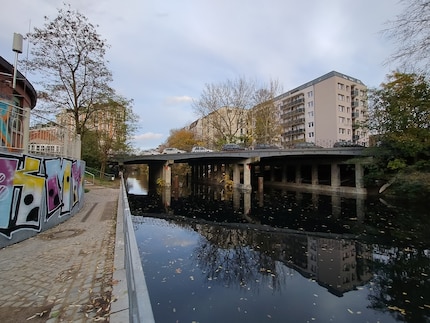
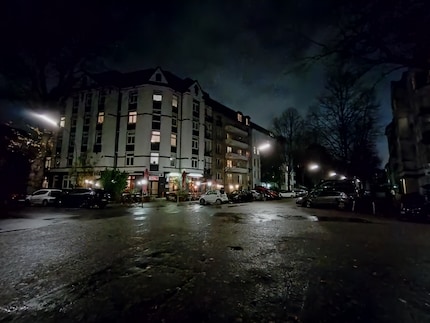
As expected, there are even fewer differences with the front camera. The level of detail is identical, but I prefer the colour of the Moto G84 slightly.
I’ll spare you the night-time selfies. They don’t look good on either smartphone – even with Night mode activated.
The software is almost identical on both smartphones. But there’s one difference. Motorola complements Android with small design adjustments and several of its own apps. For example, you can use these to set up a separate area for your children so that they can’t access your data when you give them your smartphone. The manufacturer clearly assembles some settings and options in the Moto app. However, the «Ready for» app, which you can use to connect Android to a Windows PC, is only available on the Moto G84.
Otherwise, you can expect Android 13, which Motorola has supplemented with four third-party apps. These can be uninstalled with little effort. In terms of updates, neither is impressive. Motorola promises an update to Android 14 and three years of security updates. This will soon no longer meet EU requirements.
Both smartphones offer Wi-Fi 5. The difference between Bluetooth 5.3 on the Moto G54 and Bluetooth 5.1 on the G84 should be insignificant for most. The question of water protection will probably draw more attention. Here, the more expensive Moto G84 with IP54 splash protection is ahead. The G54 is only water-repellent – without a certification.
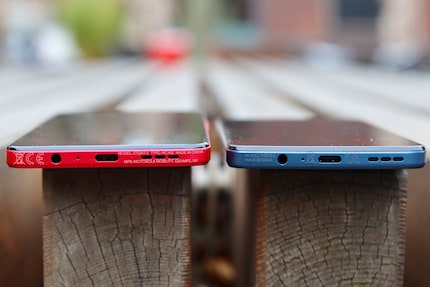
The fingerprint sensors both work reliably. It’s a matter of taste whether you prefer one in the power button for the Moto G54 or one under the display of the Moto G84.
In terms of sound, both smartphones are again very alike, meaning slightly below average, somewhat tinny and without much volume – but at least there’s stereo from two speakers. If I had to choose, I’d go for the G84.
The Moto G54 and the Moto G84 fulfil the basic requirements for smartphones. You can use them to text, surf the internet, use apps and play simple games. They deliver usable photos in daylight. But for really good photos and more power for video editing or graphically demanding games, you’ll have to spend more money.
Unsurprisingly, the Moto G84 lies slightly ahead in an overall ranking – especially in terms of the display and battery life. As for the camera and software, it’s a tie with a slight bias towards the G84. The Moto G54 only does slightly better in terms of performance.
Nevertheless, the Moto G54 seems perfectly fine for its price to me. Any improvements made to the Moto G84 are too small for the extra price. I’d rather spend a little more and go for the Edge 30 Neo if it really has to be Motorola. Or the Samsung Galaxy A34 if you’re looking for a mid-range smartphone with an attractive price-performance ratio.
Header image: Jan JohannsenAs a primary school pupil, I used to sit in a friend's living room with many of my classmates to play the Super NES. Now I get my hands on the latest technology and test it for you. In recent years at Curved, Computer Bild and Netzwelt, now at Digitec and Galaxus.